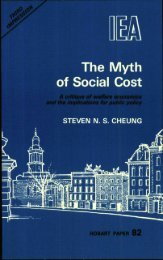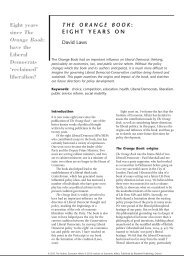Hayek's The Constitution of Liberty - Institute of Economic Affairs
Hayek's The Constitution of Liberty - Institute of Economic Affairs
Hayek's The Constitution of Liberty - Institute of Economic Affairs
You also want an ePaper? Increase the reach of your titles
YUMPU automatically turns print PDFs into web optimized ePapers that Google loves.
h ay e k ’ s t h e c o n s t i t u t i o n o f l i b e r t y<br />
t h e u s e a n d l i m i t s o f k n o w l e d g e<br />
time rules were no more than behavioural dispositions. <strong>The</strong>ir<br />
articulation in speech and in writing came very late in the process<br />
<strong>of</strong> human evolution; and even now, our compliance with rules has<br />
mostly a subconscious and habitual character.<br />
Hayek frames the story <strong>of</strong> human evolution in terms <strong>of</strong> the<br />
genesis, diffusion and transmission <strong>of</strong> rules. Elements <strong>of</strong> this<br />
story appear in <strong>The</strong> <strong>Constitution</strong> <strong>of</strong> <strong>Liberty</strong>, but it is presented much<br />
more clearly in later writings. In his most detailed account <strong>of</strong> the<br />
matter, Hayek identifies three stages <strong>of</strong> evolution, each <strong>of</strong> which<br />
involves rule-governed behaviour, but with great variation in both<br />
the character <strong>of</strong> the rules and the behaviour itself. This account is<br />
necessarily conjectural, since it looks back at least a million years,<br />
long before the beginnings <strong>of</strong> recorded history.<br />
Hayek speculates that primitive society consisted <strong>of</strong> small<br />
bands <strong>of</strong> 15 to 40 persons, who lived by hunting and gathering.<br />
Its rules were nothing more than instinctive dispositions to act<br />
in ways that favoured group solidarity and survival. How did<br />
general rules emerge? Hayek attaches great importance to the<br />
mind’s facility <strong>of</strong> treating particulars as members <strong>of</strong> a class – what<br />
he calls ‘abstraction.’ Verbal statements are a clear example, but<br />
so are our behavioural responses. Abstraction ‘manifests itself<br />
also in the way in which we respond similarly to any one <strong>of</strong> a<br />
class <strong>of</strong> events which in most respects may be very different from<br />
one another, and the feelings which are evoked by those events<br />
and which guide our action, be it a sense <strong>of</strong> justice or <strong>of</strong> moral or<br />
aesthetic approval or disapproval’ (40, 452, n. 4; cf. Hayek, 1952a:<br />
142–6; and Hayek, 1978a: 35–49). This subconscious, responsive<br />
form <strong>of</strong> abstraction developed as human beings moved through<br />
different social structures; and the most efficient <strong>of</strong> these abstract<br />
behavioural rules were spread through imitation (observers<br />
acquired the rule by imitating particular actions that exemplified<br />
it) and were enforced by social pressures. <strong>The</strong> verbal articulation<br />
<strong>of</strong> learnt rules began about eight thousand years ago, and written<br />
codes <strong>of</strong> morality and law are much more recent. Even after these<br />
developments, subconscious abstraction would continue to exert<br />
a dominant influence on human action (see 61–7, 148–9, 151–2;<br />
Hayek, 1973: 17–21, 74–6; Hayek, 1979: 159–61).<br />
Our present stock <strong>of</strong> knowledge consists in large degree <strong>of</strong><br />
rules that we have acquired through habit, custom and tradition.<br />
Social evolution tends to be cumulative, so that traces <strong>of</strong> earlier<br />
rules are brought forward into the present, where they exist in a<br />
layered or stratified form.<br />
Using contemporaneous knowledge: imitation, prices<br />
and esteem<br />
Transmission in time is one <strong>of</strong> the ways by which knowledge<br />
becomes available for our use. <strong>The</strong> other way is through communication<br />
among contemporaries, three examples <strong>of</strong> which are: a)<br />
‘individuals imitating those who have been more successful;’ b)<br />
individuals being guided by ‘prices <strong>of</strong>fered for their products;’ and<br />
c) individuals responding to ‘expressions <strong>of</strong> moral or aesthetic<br />
esteem for their having observed standards <strong>of</strong> conduct’ (28–9).<br />
All three processes are vital to civilisation. Imitation is essential<br />
to society’s adaptive evolution, where ‘the decisive factor is not the<br />
selection <strong>of</strong> the physical and inheritable properties <strong>of</strong> the individuals<br />
but the selection by imitation <strong>of</strong> successful institutions and<br />
habits’ (59). Prices convey vital information about the economic<br />
behaviour <strong>of</strong> dispersed individuals. Signs <strong>of</strong> approval or disapproval<br />
promote conformity to rules.<br />
56<br />
57












